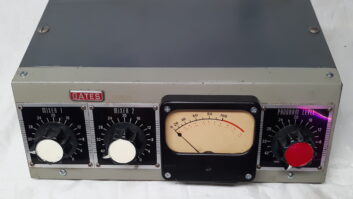Joe Jarjoara is engineering manager for the stations owned by Quantum Communications of Cape Cod. Last winter, Joe inspected one of his sites to find evidence of what appeared to be something nesting in one of his antenna bays.
(click thumbnail)Fig. 1: Things are not always as they appear from down on the ground.Figs. 1 and 2 reveal that what looked from the ground like nest material actually was a portion of the fiberglass radome. Fig. 2 shows the view from the top, with a portion of the radome completely gone.
The day before, freak thunderstorms had moved through the area. The culprit became clear.
He forwarded his photos to Angela Gillespie of Shively Labs, the antenna manufacturer, to get their assessment that lightning did indeed cause the damage. This became his final supporting document. Now, armed with a printout of the weather forecast, his pictures and a letter from the manufacturer, Joe was ready for an insurance claim. Joe’s preparation made for speedy processing of the claim.
His experience underscores the need to keep that digital camera handy, especially as storms roll through. Many times we’re in such a hurry to get a problem corrected that the thought of documenting the damage before it is repaired never enters our mind.
With a camera in your hands, photos of claim damage are hard to dispute.
* * *
Energy Transformation Systems of Fremont, Calif., is a producer of baluns and other devices for audio/video, telco and data applications. ETS has introduced a brushed stainless wall-plate version of its InstaSnake, as seen in Fig. 3.
(click thumbnail)Fig. 2: Lightning melted this radome.A pair of these U.S.-made passive units will send up to four audio signals over a single run of CAT-5, -5E, or -6 cable. InstaSnake has been tested to 1,900 feet over CAT-5, using low-impedance dynamic microphones.
Information can be found at the ETS Web site, www.etslan.com.
* * *
Edd Monskie, vice president of engineering for Hall Communications, writes that he and his staff are in the middle of building a 700-foot tower in central Florida.
As with almost any part of the state, there are designated “wetlands” close to the tower. (They are so designated by the Southwest Florida Water Management District or SWFWMD, commonly known as “swiftmud.”)
In placing the tower, the team ended up rotating guy points from their original locations in order to miss the wetlands.
But this still put a wetland area between the tower base and one set of guy anchors. The crew could not plow or construct any type of roadway across the wetland for vehicles or people to cross. But somehow, the tower team had to get the guy cables across the wetlands during construction.
Their first thought was to buy chest waders. They took two steps into the water and were up to the middle of their chests in the water.
(This method also did not take into account that a six-foot alligator lives in that wetland area. The crew can hear him every morning and has seen him floating about.)
The guys still had to get across. That’s when one of the crew found a solution. An avid bow hunter, he had his compound bow with him on site, so he tied a fishing line (60-pound test) to an arrow.
(click thumbnail)Fig. 3: ETS now offers CAT-5 mic snake cabling wallplates.The first attempt with an arrow resulted in a broken fishing line and an arrow lost in the wetland. But on the second attempt, he was able to shoot the line about 40 yards across the swamp to the other side. The crew then used the fishing line to pull a rope across the swamp.
Using a combination of the rope and winches, the heavy guy cables were brought across the wetland to begin the tower erection.
Engineers (and tower crews) are some of the most ingenious people.
* * *
Tom Norman is a senior engineer with Burst Video in Colorado. He writes that Winston Hawkins’ note about using a rack shelf upside down to aid in installing or removing equipment (Workbench, April 9) is a winner.
Tom has used another technique that may be handy even if you have an assistant around, and it will work if you don’t have a rack shelf.
Immediately below any given piece of equipment will typically be rack screw holes that can be freed up. Install screws immediately below the gear, with about 3/8-inch of the thread showing. This affords a secure temporary platform on which to rest a piece of gear during removal.
You can wrestle it with a little less concern if the side opposite the one you are working on is nominally secure, resting on the protruding rack bolt. Nevertheless, Tom adds that he’s had gear slip off the screw on the side he was not handling, creating a bit of excitement. Winston’s solution completely avoids this problem.













